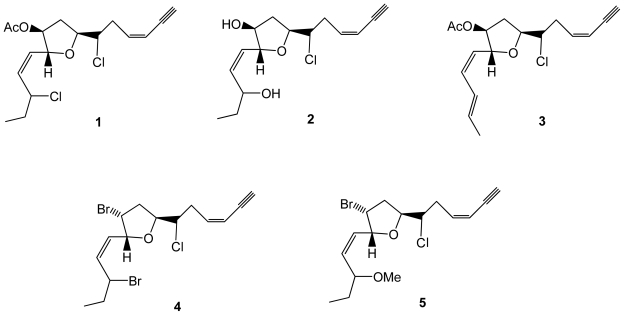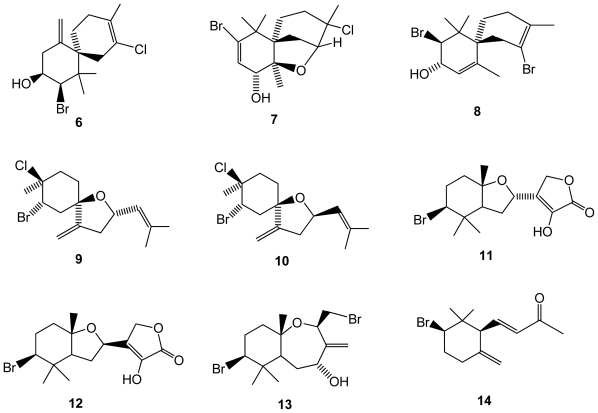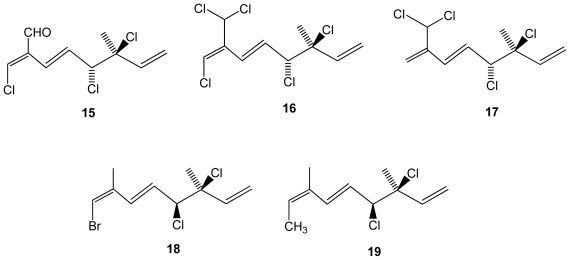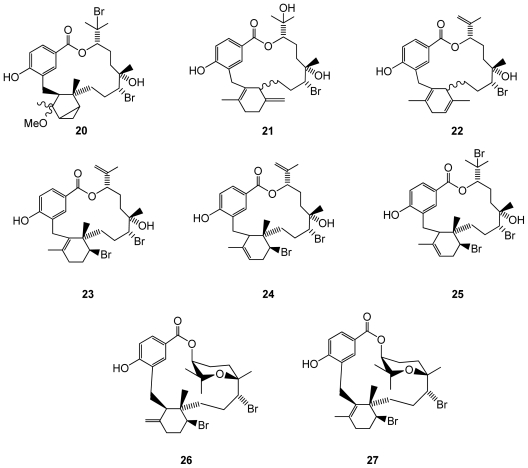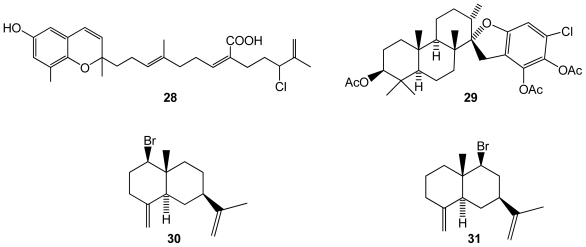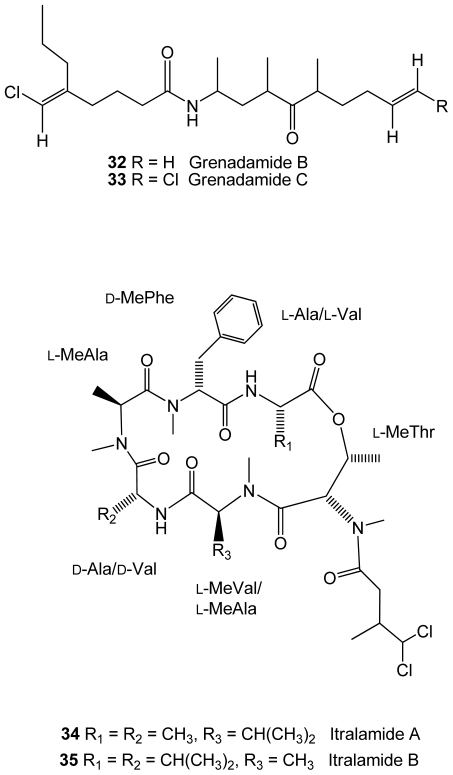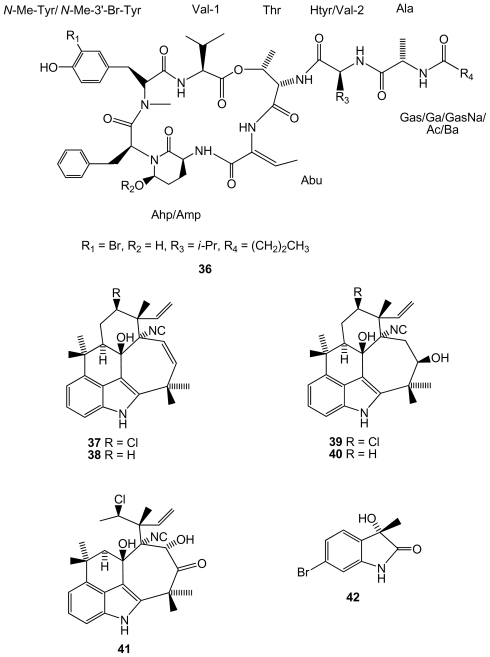Abstract
Marine algae produce a cocktail of halogenated metabolites with potential commercial value. Structures exhibited by these compounds go from acyclic entities with a linear chain to complex polycyclic molecules. Their medical and pharmaceutical application has been investigated for a few decades, however other properties, such as antifouling, are not to be discarded. Many compounds were discovered in the last years, although the need for new drugs keeps this field open as many algal species are poorly screened. The ecological role of marine algal halogenated metabolites has somehow been overlooked. This new research field will provide valuable and novel insight into the marine ecosystem dynamics as well as a new approach to comprehending biodiversity. Furthermore, understanding interactions between halogenated compound production by algae and the environment, including anthropogenic or global climate changes, is a challenging target for the coming years. Research of halogenated metabolites has been more focused on macroalgae than on phytoplankton. However, phytoplankton could be a very promising material since it is the base of the marine food chain with quick adaptation to environmental changes, which undoubtedly has consequences on secondary metabolism. This paper reviews recent progress on this field and presents trends on the role of marine algae as producers of halogenated compounds.
Keywords: marine algae, halogenated compounds, biotechnological applications, ecological role
1. Introduction
Marine algae produce a wide variety of remarkable natural compounds, usually referred to as secondary metabolites because they are not involved in the basic machinery of life [1]. Although these molecules often contribute to only a very small fraction of the organism total biomass [2], the contribution of these compounds to survival may sometimes be comparable to metabolites resulting from the primary metabolism [3]. In that sense, the use of the term “secondary metabolite” seems less appropriate since these compounds also contribute to growth, reproduction and defense and thus play a primary role for the organism integrity.
Many of these secondary metabolites are halogenated, reflecting the availability of chloride and bromide ions in seawater. Interestingly, bromide is more frequently used by algae for organohalogen production, although chlorine occurs in higher concentrations than bromine in seawater. Marine halogenated compounds comprise a varied assembly of compounds, ranging from peptides, polyketides, indoles, terpenes, acetogenins and phenols to volatile halogenated hydrocarbons [4]. The prevalence of halogens is not similar in marine algae: chlorine and bromine appear to be the main halogens used to increase biological activity of secondary metabolites, whereas iodine and fluorine remain quite unusual within the chemical structures [5]. However, some orders of brown algae such as Laminariales accumulate and use iodine for halogenation processes. For example, the kelp Laminaria digitata accumulates iodine to more than 30,000-times the concentration found in seawater, representing an average content of 1% of dry weight [6]. In fact, iodination is more frequent in brown algae than in red and green algae metabolites [6]. As a result, only less than 1% of secondary metabolites from of brown algae contain bromine or chlorine in contrast with as much as 90 and 7% of red and green algal compounds, respectively [7].
Halogenation often provides these compounds with interesting key features and marine algae hold diverse and unique biosynthetic pathways for the production of halogenated metabolites. The halogenated sesterterpenes, neomangicols A–C, isolated from the marine fungus Fusarium [8], offer a striking example of the halogenation effect. Neomangicol A and B display in vitro cytotoxic effect toward the HCT-116 human colon tumor cell line, while their nonhalogenated analog neomangicol C was shown to be inactive [8].
Biological properties of halogenated compounds have been researched for the past decades, with results showing antibacterial, antifungal, antiviral, anti-inflammatory, antiproliferative, antifouling, antifeedant, cytotoxic, ichthyotoxic, and insecticidal activity [9]. Research major focal points indubitably have been the discovery and characterization of new halogenated compounds, along with a remarkable effort toward the evaluation of their possible biomedical and biotechnological applications. Also, chemical profiles have been used to differentiate cryptic species but the chemotaxonomic value of natural halogenated compounds has been questioned due to geographical and seasonal variations in the chemical composition of algal species [10]. The ecological role of marine halogenated metabolites, alongside with other natural compounds, has been disregarded, although a few halogenated metabolites have been shown to have important and critical roles on the community structure of marine ecosystems in previous years [11–17]. In fact, most of the publications on marine ecological issues rarely include a chemical approach of compounds responsible for the ecological interactions found. Excellent reviews on marine natural compounds have been recently published [9,18,19], with no particular emphasis on halogenated metabolites. These showed a variety of structure types that were isolated from a wide range of marine organisms, including microorganisms and phytoplankton, macroalgae, sponges, cnidarians, bryozoans, molluscs, tunicates, echinoderms and true mangrove plants. During 2009, new naturally occurring algal halogenated compounds were found, most of them with little or no reported biological activity. Reports on the ecological role of algal natural compounds, presenting both chemical and ecological approaches were still few. The present paper focuses on halogenated compounds only, and is restricted to micro and macroalgae as natural sources. It attempts to provide an overview of new marine halogenated compounds reported in 2009 and to examine progress and present trends on the role of marine algae as producers of halogenated compounds.
2. Macroalgae
Interest in the actual marine natural compounds responsible for such a wide range of properties is far more recent and new compounds are still being discovered and isolated, chemical structures elucidated and properties being sorted out, with the aim of finding new molecular entities with industrial application. From time to time, a new compound emerges as particularly promising in a specific area and additional testing starts to allow further pharmacological evaluation.
Many compounds have been found in marine macroalgae in recent years, mainly in red and brown algae, and fewer in green algae [9]. Among all marine macroalgae, red algae are the main producers of halogenated compounds. Laurencia (family Rhodomalaceae, order Ceramiales, class Rhodophyceae, phylum Rhodophyta) is considered one of the most prolific genera [20,21], being mainly found in tropical, subtropical, and temperate coastal waters. It has been intensively screened over the last fifty years, although a variety of new halogenated molecules are still being reported. Characteristically, the halogenation degree found in compounds from Laurencia is relatively high [19]. Diterpenes sesquiterpenes, triterpenes, and C15-acetogenins are the main secondary compounds of this genus [22,23] with which antimicrobial [24], antifeedant [25], antihelmintic [26,27] and cytotoxic [28,29] properties are generally associated.
Five new chlorinated compounds, C15 acetogenin en-ynes (1–5), were obtained from Laurencia glandulifera collected from the island of Crete (Figure 1). Four of them were evaluated for their cytotoxicity toward HT-29 (colorectal adenocarcinoma), MCF-7 (mammary adenocarcinoma), PC-3 (prostate adenocarcinoma), HeLa (cervical adenocarcinoma), and A431 (epidermoid carcinoma) human tumor cell lines, but no significant activity was found [30]. The characteristic terminal cis ene-yne moiety is also present in C15 eight-membered cyclic ethers previously isolated from L. glandulifera collected on the Crete Island, which exhibited antistaphylococcal activity with minimum inhibitory concentrations (MICs) in the range of 8–256 mg/mL [31].
Figure 1.
Structures of compounds 1–5 isolated from Laurencia glandulifera.
Elatol (6)(Figure 2), a halogenated sesquiterpene alcohol, commonly found in many species of Laurencia, and known for its potent antibacterial activity, was isolated for the first time in Laurencia microcladia, collected in the Southern Brazilian coast [32]. Previous analysis of anti-herbivory proprieties of metabolites from Laurencia species (including elatol) have been conducted but no investigation had been reported for Laurencia microcladia. Elatol anti-herbivory properties were investigated using the black sea urchin Echinometra lucunter, but it was found that this species can tolerate elatol, at least in the concentrations tested [32]. However, this compound was able to deter feeding of Thalassia by reef fishes with a reduced loss of Thalassia by 60% and was shown to be a very efficient deterrent against the sea urchin Diadema antillarum, reducing grazing by 86% [11]. However, anti-herbivory proprieties could not be detected by testing the compound on the black sea urchin Echinometra lucunter.
Figure 2.
Structures of halogenated compounds 6–14 isolated from Laurencia saitoi.
Laurencia saitoi, with exceptionally few reported halogenated compounds [25] in the past, was found to produce four novel halogenated sesquiterpenes: 10-bromo-3-chloro-2,7-epoxychamigr-9-en- 8-ol (7), 2,10-dibromochamigra-2,7-dien-9-ol (8), (9S)-2-bromo-3-chloro-6,9-epoxybisabola-7(14),10-diene (9), and (9R)-2-bromo-3-chloro-6,9-epoxybisabola-7(14),10-diene (10)[33](Figure 2). In addition, other brominated compounds were already reported for different macroalgal species, namely aplysistatin, a well known antileukemic agent [34,35], 5-acetoxypalisadin B, palisadin A, palisadin B belonging to a series of antimicrobial compounds, and 2,3,5,6-tetrabromoindole [36]. Cytotoxicity of the isolated compounds was evaluated by the MTT method, all the tested compounds being found inactive [36]. New brominated sesquiterpenes and a norsesquiterpene were also reported from the same species [37], namely 2-hydroxyluzofuranone (11), 2-hydroxyluzofuranone B (12), 4-hydroxypalisadin C (13), and 2-bromo-γ-ionone (14)(Figure 2).
Other red algal genera have also been screened and interesting findings were recently reported. From the chemical-rich genus Plocamium, a South African red algae Plocamium cornutum yielded five halogenated monoterpenes (15–19) from which two are new (compounds 18–19)(Figure 3). The antiplasmodial activity against the chloroquine sensitive strain of the most frequent and deadly human malaria parasite Plasmodium falciparum was tested. Although the compounds were significantly less active than standard chloroquine, compounds 16 and 17 containing 7-dichloromethyl moiety were the most active ones (IC50 = 16 and 17 μM, respectively), followed by compound 15 (IC50 = 27 Mm), which contains an aldehyde functional group at this position, while the new compounds were essentially inactive [38].
Figure 3.
Structures of monoterpenes 15–19 isolated from Plocamium cornutum.
Another red algal species, the Fijian Callophycus serratus, was found to produce eight bromophycolides J–Q (20–27)(Figure 4), which exhibited IC50 values against Plasmodium falciparum in the low micromolar range (44 for compound 22, 0.5 for 23, 1.4 for 24, 25 and 27)[39]. Antimalarian activity appeared to be associated with the presence of a macrolide motif in the chemical structure of these molecules. Antibacterial assays were performed using methicillin-resistant Staphylococcus aureus and vancoymcin-resistant Enterococcus faecium as test pathogens. The macrolides were also evaluated against a panel of 12 tumor cell lines including breast, colon, lung, prostate, and ovarian cancer cells. Of the eight tested compounds, bromophycolides 26 and 27 exhibited the most potent antibacterial activity against S. aureus and E. faecium, suggesting that conformational rigidity and/or hydrophobicity conferred by the tetrahydropyran system contributes to antibacterial activity. While all tested bromophycolides exhibited moderate antineoplastic activity, only 24 displayed some cell line selectivity, with an IC50 of 1.5 μM against the breast tumor cell line. Interestingly, while 24 demonstrated cancer cell line selectivity, its regioisomer 23 was quite active against all cancer cell lines tested (IC50’s 2.1–7.2 μM). Bromophycolide 27 was the most potent C. serratus natural product evaluated but showed little cell line selectivity.
Figure 4.
Structures of bromophycolides 20–27 from Callophycus serratus.
Halogenated metabolites from brown algae, reported as unusual for this algal group [40], have been found to be mainly terpenes. However, some new molecules were reported for brown algae in 2009. A new halogenated meroditerpenoid, fallachromenoic acid (28)(Figure 5), was isolated from the southern Australian brown algae Sargassum fallax, and displayed antitumor activities against a P388 Murine Leukaemia cell line [41]. Although there were no previous reports of halogenated compounds in the Stypopodium genus, Areche et al. [40] found an unusual 40-chlorostypotriol triacetate (29)(Figure 5) in Stypopodium flabelliforme, from which biological properties are still unknown. Another brown algal species, Dictyopteris divaricata, was found to produce two new brominated selinane sesquiterpenes, 1-bromoselin-4(14),11-diene (30) and 9-bromoselin-4(14),11-diene (31)[42](Figure 5).
Figure 5.
Structures of compounds 28–31 isolated from brown algae.
No reports associated with green algae were found in the selected bibliography from 2009.
3. Cyanobacteria
Marine phytoplankton has been much less investigated than macroalgae although marine microorganisms are, in general, increasingly considered successful sources of natural products. Earlier reviews and reports on marine natural products including phytoplankton refer mainly to cyanobacteria and dinoflagellates [9,18,43,44] as sources of natural compounds.
Selected examples of recently discovered halogenated molecules produced by marine phytoplankton, from 2009 literature, exhibited the same trend. Among phytoplankton major groups, cyanobacteria have come forward as one of the most promising groups of microorganisms for the isolation of interesting new natural halogenated compounds [45,46]. A wide range of compounds with different properties is produced by these blue-green algae [44]. For example, many of these compounds were found to be anticancer agents or powerful neurotoxins performing either as blockers or activators of the eukaryotic voltage-gated sodium (Nav) channels [44].
Cyanobacterial toxins have received increased research effort in recent years [47–49] because these molecules are among the most found hazardous substances in surface waters and occurrence of harmful cyanobacterial bloom events is rising worldwide [50].
The cyanobacteria Lyngbya majuscula, from an Eastern Caribbean collection, was found to produce two new halogenated fatty acid amides, grenadamides B and C (32–33), and two new depsipeptides, itralamides A and B (34–35)[51](Figure 6). The first two compounds displayed marginal activity against the beet armyworm (Spodoptera exigua).
Figure 6.
Structures of compounds 32–35 isolated from the cyanobacteria Lyngbya majuscula.
From the same genus, a new brominated compound, lyngbyastatin 10 (36)(Figure 7), closely related to lyngbyastatins, was found in Lyngbya semiplena, collected in Tumon Bay (Guam, Pacific ocean), inhibiting porcine pancreatic elastase [52]. Another cyanobacteria, Fischerella ambigua, obtained from a culture, produces five newly found antibacterial chlorinated molecules, ambiguine K–O isonitriles (37–41)[53](Figure 7). Ambiguine K and M isonitriles showed the most potent activity against Mycobacterium tuberculosis, the causal agent of most cases of tuberculosis. Ambiguine A isonitrile was the most active one against Bacillus anthracis, the bacterium that causes anthrax. A new brominated indole alkaloid, named as bromoanaindolone, (IUPAC name: 6-bromo-3-hydroxy-3-methyl-indol-2-one)(42)(Figure 7), yielded by the cyanobacteria Anabaena constricta [54], showed antibacterial activity against the Gram-positive species Bacillus cereus, the bacterium that causes foodborne disease commonly known as food poisoning. Bromoanaindolone also displayed anticyanobacterial activity against the filamentous species Arthrospira laxissima and Nostoc carneum, and also against the unicellular species Chroococcus minutus, Synechocystis aquatilis and Synechococcus sp., which indicates the allelopathic potential of this compound.
Figure 7.
Structures of compounds 36–42 isolated from cyanobacteria.
4. Limitations and Possible Solutions to Detection of Bioactivity
The fact that some of the newly found halogenated compounds show minor or no activity at all against a specific target does not exclude the possibility of other hidden unidentified active biological effects. Additionally, the supposedly absence of bioresponse may be related to limitations in the analytical chemistry methods employed. Bioassay-guided fractionation is the iterative approach traditionally applied to disclose bioactive natural compounds [55,56]. Difficulties in perception of bioactivity may be linked to compound instability, caused by fractionation and isolation from the natural cellular environment or simply because compounds may act synergistically or more than one compound may be associated to a specific property. This is particularly true for macroalgae and microalgae which are complex compound matrices [57]. Metabolite-oriented approaches, namely metabolite profiling and metabolomics, may supplement bioassay-guided fractionation [58]. These two approaches are focused on the chemical properties of the metabolome, which includes the complete set of metabolites of an organism (metabolomics), or of a limited group of pre-defined metabolites (metabolite profiling)[59]. In the latter approach, pre-defined metabolites are selected either according to the class they belong to (organic phosphates, carbohydrates, etc.) or to an associated specific pathway. Both metabolite profiling and metabolomics allow all compounds to be simultaneously measured, so that detection of unstable compounds is facilitated and synergistic effects detected [59]. Also, the influence of a particular condition on the organism physiology can be revealed through qualitative and quantitative differences in the metabolic profiles obtained [60,61]. This could be a valuable tool for the assessment of effects of environmental changes on the community structure and organism physiology. However, useful metabolomics may be used for a more thorough and complete detection of metabolites, limitations subsist when applied to chemical ecology, due to the difficulty in establishing a link between one or more specific metabolites and an ecological role [58].
Other techniques have been applied for the study of halogenated compounds in marine algae. Desorption electrospray ionization mass spectrometry (DESI-MS) and some applications, such as imaging, have very recently started to be used for natural products detection on intact algal tissue surfaces [62,63]. DESI-MS is an ambient ionization technique coupled with mass spectrometry, allowing probing the surface of solids, liquids, frozen solutions, and adsorbed gases [64]. In ambient DESI-MS, samples are kept under atmospheric pressure in open air, with minimum or no preparation at all [64]. Tissue surfaces are subject to a focused spray of charged particles of a polar solvent, which leads to the release of intact gaseous ions from surfaces into the mass spectrometer [65]. Low detection limits and high analysis speed are achieved, and innate chemical information is preserved to a maximum [64]. DESI-MS has been shown to be a sensitive and effective approach to detect algal diterpene-benzoate macrolide natural products, namely bromophycolides, directly on the surface and interior of a marine red alga, Callophycus serratus [62]. Reactive DESI approaches were investigated to improve ionization efficiency and detection limits. Different polar solvent compositions, tested directly on the algal surfaces, were demonstrated to enhance sensitivity for discovery of various bromophycolides, which would have otherwise been undetected. Imaging, one of DESI-MS possible applications, has been shown to provide an exceptional capability to map secondary metabolites to distinct algal surface sites [63]. Bromophycolides were shown to be non homogenously distributed across surfaces but instead associated with distinct patches, again in the red algae Callophycus serratus. DESI-MS imaging appears to be a powerful tool for the investigation of the function of surface-associated natural products in ecological interactions, as spatially-resolved measurements with lateral resolutions in the hundreds of micrometers are made possible. These studies [62,63] illustrate the potential of DESI-MS and its applications, such as imaging, in understanding chemically-mediated biological processes in macroalgae.
5. Ecological Role
Micro and macroalgal survival and success in the marine environment reflect to a great extent the many strategies these organisms have had to employ throughout their evolutionary history to adapt to a hostile and high resource-demanding milieu. Extreme competition for space, light and nutrients has shaped the organisms’ physiology, resulting in a complex array of biologically active metabolites characteristic of each species. Many of these secondary metabolites have been shown to support the defense mechanisms developed by marine algae [66–69]. Secondary metabolites are now suggested to be responsible for marine biodiversity on the genetic, species, and ecosystem levels [70,71].
Chemical ecology, which tackles the role of natural compounds in the interactions between organisms and also between organisms and their environment, has already a few decades of investigation dedicated to marine systems [46]. Historically, interest in natural products from marine algae was initially driven to meet pressing biomedical requirements for new drugs against fungal [72], parasitic [73], bacterial [74], and viral [75] diseases, which were either used in their natural form or as templates for synthesis and further chemical structure modification [46]. For this purpose, macroalgae from tropical areas were heavily screened and many new halogenated compounds were found in the last decade [18]. Apart from potent and original therapeutic agents for infectious diseases and cancer, among many other disorders, natural products isolated from marine algae were also found to clearly control interactions between organisms [11–13], and therefore influence population structure, communities organization, and ecosystem function [14–17]. Biodiversity in marine systems may be a result of chemical diversity [68]. Presently, specific ecological aspects such as chemical sensing of the environment by algae, intraspecific signaling, allelopathy, predator-prey and host-parasite interactions, and bioaccumulation and transfer of toxins within food webs have been addressed on recent research on the ecology of natural compounds from marine algae. Excellent reviews and essays on marine chemical ecology covering years prior to 2009 have been published (see [3,17,68,76–78]), however, with no particular focus on halogenated compounds. Interactions between algae and herbivorous invertebrates or describing allelopathic effects have received most of the attention. These ecological interactions continue to be predominantly documented from an ecological perspective [79,80]; the chemical identification of compounds responsible for the found ecological relationships was overlooked during 2009. A multidisciplinary approach including organic chemistry, biology, and ecology components is required for the in depth elucidation of the ecological relationships in the near future. So far, the ecological and the chemical approaches rarely coincide in the same study; the cellular and molecular bases for these interactions remain disregarded. In fact, to the best of our knowledge, an ecological study on marine macroalgae, including elucidation of chemical structure of molecules responsible for ecological interactions, was found during 2009. A direct fine-scale evaluation of bromophycolides and callophycoic acids was conducted on red macroalga Callophycus serratus surfaces in order to evaluate whether these natural compounds had a role in surface-mediated defense against pathogenic microbes [63]. These novel compounds had been reported for the first time in C. serratus [39], represent the largest group of algal antifungal compounds described to date, and were shown to inhibit growth of Lindra thalassiae, a marine pathogenic fungus [63]. DESI-MS imaging revealed bromophycolides among heterogeneous patches on algal surfaces and within internal algal tissues. The bromophycolide concentrations found on these surface patches were sufficient suppress growth of L. thalassia, indicating that probably these compounds are kept internally and released at sparsely distributed surface sites. The above cited study [63] provides the first direct evidence for localization of chemical signals with spatial resolution <200 μm on biological surfaces in concentrations sufficient for targeted antimicrobial defense, highlighting the potential of DESI-MS imaging for the understanding of small-scale ecological interactions.
6. Present Trends
A lot still remains to be done concerning research on the role of marine natural halogenated compounds: (i) isolation and characterization of new halogenated compounds (ii) screening untested micro and macroalgal species (iii) improving assessment in the detection of bioactivities, fully exploring potential of metabolite-oriented approaches, (iv) testing biomedical and ecological relevance of novel and known chemical natural compounds, (v) ensuring reliable taxonomic identification of investigated species, (vi) biogeographical assessing of micro- and macroalgae with relevant compounds, and (vii) developing appropriate strategies for data management.
From a purely ecological point of view, success toward the in-depth understanding of marine ecological interactions is very much dependent on a multidisciplinary approach, relying on adequate bioactivity detection methodologies. Chemical metabolite-oriented approaches may prove to be reliable tools helping to elucidate compound’s biological properties, which may not be detectable in any other way. Ecological studies may just benefit from an interactive and close combination of chemical methodologies with ecological experiments.
Acknowledgements
This study was funded by “Fundação para a Ciência e Tecnologia” grant SFRH/BPD/50348/2009 to M.T. Cabrita.
References
- 1.Cimino G, Ghiselin MT. Marine natural products chemistry as an evolutionary narrative. In: McClintock JB, Baker BJ, editors. Marine Chemical Ecology. CRC Press; Boca Raton, FL, USA: 2001. pp. 115–154. [Google Scholar]
- 2.Cannell RJP. How to approach the isolation of a natural product. In: Cannell RPJ, editor. Natural Products Isolation, Methods in Biotechnology. Vol. 4. Humana Press; Totowa, NJ, USA: 1998. pp. 1–51. [Google Scholar]
- 3.Ianora A, Boersma M, Casotti R, Fontana A, Harder J, Hoffmann F, Pavia H, Potin P, Poulet SA, Toth G. New trends in marine chemical ecology. Estuaries Coasts. 2006;29:531–551. [Google Scholar]
- 4.Butler A, Sandy M. Mechanistic considerations of halogenating enzymes. Nature. 2009;460:848–854. doi: 10.1038/nature08303. [DOI] [PubMed] [Google Scholar]
- 5.Neumann CS, Fujimori DG, Walsh CT. Halogenation strategies in natural product biosynthesis. Chem. Biol. 2008;15:99–109. doi: 10.1016/j.chembiol.2008.01.006. [DOI] [PubMed] [Google Scholar]
- 6.Küpper FC, Schweigert N, Ar Gall E, Legendre J-M, Vilter H, Kloareg B. Iodine uptake in Laminariales involves extracellular, haloperoxidase-mediated oxidation of iodide. Planta. 1998;207:163–167. [Google Scholar]
- 7.Harper MK, Bugni TS, Copp BR, James RD, Lindsay BS, Richardson AD, Schnabel PC, Tasdemir D, Van Wagoner RM, Verbitzki SM, Ireland CM. Introduction to the chemical ecology of marine natural products. In: McClintock JB, Baker BJ, editors. Marine Chemical Ecology. CRC; Boca Raton, FL, USA: 2001. pp. 3–71. [Google Scholar]
- 8.Renner MK, Jensen PR, Fenical W. Neomangicols: structures and absolute stereochemistries of unprecedented halogenated sesterterpenes from a marine fungus of the genus Fusarium. J. Org. Chem. 1998;63:8346–8354. [Google Scholar]
- 9.Blunt JW, Copp BR, Hu WP, Munro MHG, Northcote PT, Prinsep MR. Marine natural products. Nat. Prod. Rep. 2009;26:170–244. doi: 10.1039/b805113p. [DOI] [PubMed] [Google Scholar]
- 10.Fenical W, Norris JN. Chemotaxonomy in marine algae: chemical separation of some Laurencia species (Rhodophyta) from the Gulf of California) J. Phycol. 1975;11:104–108. [Google Scholar]
- 11.Hay ME, Fenical W, Gustafson K. Chemical defense against diverse coral-reef herbivores. Ecology. 1987;68:1581–1591. doi: 10.2307/1939850. [DOI] [PubMed] [Google Scholar]
- 12.Vairappan CS. Potent antibacterial activity of halogenated metabolites from Malaysian red algae, Laurencia majuscula (Rhodomelaceae, Ceramiales) Biomol. Eng. 2003;20:255–259. doi: 10.1016/s1389-0344(03)00067-4. [DOI] [PubMed] [Google Scholar]
- 13.Vairappan CS, Ang MY, Ong CY, Phang SM. Biologically active polybrominated indoles in the red alga Laurencia similis from the coastal waters of Sabah (Rhodomelaceae, Ceramiales) Malaysian J. Sci. 2004;23:119–126. [Google Scholar]
- 14.Paul NA, de Nys R, Steinberg PD. Seaweed–herbivore interactions at a small scale: direct tests of feeding deterrence by filamentous algae. Mar. Ecol. Prog. Ser. 2006;323:1–9. [Google Scholar]
- 15.Harlin MM, Rice EL. Allelochemistry in marine macroalgae. Crit. Rev. Plant Sci. 1987;3:237–249. [Google Scholar]
- 16.Bolser RC, Hay ME. Are tropical plants better defended? Palatability and defenses of temperate vs. tropical seaweeds. Ecology. 1996;77:2269–2286. [Google Scholar]
- 17.Hay ME. Marine chemical ecology: Chemical signals and cues structure marine populations, communities, and ecosystems. Annu. Rev. Mar. Sci. 2009;1:193–212. doi: 10.1146/annurev.marine.010908.163708. [DOI] [PMC free article] [PubMed] [Google Scholar]
- 18.Blunt JW, Copp BR, Hu W-P, Munro MHG, Northcote PT, Prinsep MR. Marine natural products. Nat. Prod. Rep. 2007;24:31–86. doi: 10.1039/b603047p. [DOI] [PubMed] [Google Scholar]
- 19.Hill RA. Marine natural products. Annu. Rep. Prog. Chem., Sect. B: Org. Chem. 2007;103:125–139. [Google Scholar]
- 20.Faulkner DJ. Marine natural products. Nat. Prod. Rep. 2001;18:1–49. doi: 10.1039/b006897g. [DOI] [PubMed] [Google Scholar]
- 21.Wright AD, Goclik E, König GM. Three new sesquiterpenes from the red alga Laurencia perforate. J. Nat. Prod. 2003;66:435–437. doi: 10.1021/np020274v. [DOI] [PubMed] [Google Scholar]
- 22.Erickson KL. Constituents of Laurencia. In: Scheuer PJ, editor. Marine Natural Products: Chemical and Biological Perspectives. Vol. 5. Academic Press; New York, NY, USA: 1983. pp. 131–257. [Google Scholar]
- 23.Faulkner DJ. Marine natural products. Nat. Prod. Rep. 1995;12:223–269. doi: 10.1039/np9900700269. [DOI] [PubMed] [Google Scholar]
- 24.König GM, Wright AD. Laurencia rigida: Chemical investigations of its antifouling dichloromethane extract. J. Nat. Prod. 1997;60:967–970. doi: 10.1021/np970181r. [DOI] [PubMed] [Google Scholar]
- 25.Kurata K, Taniguchi K, Agatsuma Y, Suzuki M. Diterpenoid feeding-deterrents from Laurencia saitoi. Phytochemistry. 1998;47:363–369. [Google Scholar]
- 26.Davyt D, Fernandez R, Suescun L, Mombrú AW, Saldaña J, Domínguez L, Coll J, Fujii MT, Do Manta E. New sesquiterpene derivatives from the red alga Laurencia scoparia. Isolation, structure determination, and anthelmintic activity. J. Nat. Prod. 2001;64:1552–1555. doi: 10.1021/np0102307. [DOI] [PubMed] [Google Scholar]
- 27.Topcu G, Aydogmus Z, Imre S, Gören AC, Pezzuto JM, Clement JA, Kingston DGI. Brominated sesquiterpenes from the red alga Laurencia obtusa. J. Nat. Prod. 2003;66:1505–1508. doi: 10.1021/np030176p. [DOI] [PubMed] [Google Scholar]
- 28.Juagdan EG, Kalidindi R, Scheuer P. Two new chamigranes from an hawaiian red alga, Laurencia cartilaginea. Tetrahedron. 1997;53:521–528. [Google Scholar]
- 29.Sun J, Shi D, Ma M, Li S, Wang S, Han L, Yang Y, Fan X, Shi J, He L. Sesquiterpenes from the red alga Laurencia tristicha. J. Nat. Prod. 2005;68:915–919. doi: 10.1021/np050096g. [DOI] [PubMed] [Google Scholar]
- 30.Kladi M, Vagias C, Papazafiri P, Brogi S, Tafi A, Roussis V. Tetrahydrofuran acetogenins from Laurencia glandulifera. J. Nat. Prod. 2009;72:190–193. doi: 10.1021/np800481w. [DOI] [PubMed] [Google Scholar]
- 31.Kladi M, Vagias C, Stavri M, Rahman M, Gibbons S, Roussis V. C15 acetogenins with antistaphylococcal activity from the red alga Laurencia glandulifera. Phytochem. Lett. 2008;1:31–36. [Google Scholar]
- 32.Lhullier C, Donnangelo A, Caro M, Palermo JA, Horta PA, Falkenberg M, Schenkel EP. Isolation of elatol from Laurencia microcladia and its palatability to the sea urchin Echinometra lucunter. Biochem. Syst. Ecol. 2009;37:254–259. [Google Scholar]
- 33.Ji N-Y, Li X-M, Li K, Wang B-G. Halogenated sesquiterpenes from the marine red alga Laurencia saitoi (Rhodomelaceae) Helv. Chim. Acta. 2009;92:1873–1879. [Google Scholar]
- 34.Pettit GR, Herald CL, Allen MS, Von Dreele RB, Vanell LD, Kao JPY, Blake W. The isolation and structure of aplysistatin. J. Am. Chem. Soc. 1977;99:262–263. doi: 10.1021/ja00443a055. [DOI] [PubMed] [Google Scholar]
- 35.Pandey PK. Endangered medicinal species of the Indian Ocean: radical need for conservation. Chem. Biodivers. 2009;6:990–1001. doi: 10.1002/cbdv.200800183. [DOI] [PubMed] [Google Scholar]
- 36.Su H, Yuan Z, Li J, Guo S, Han L, Zhu X, Shi D. Studies on chemical constituents of Laurencia saitoi. Zhongguo Zhong Yao Za Zhi. 2009;34:871–874. [PubMed] [Google Scholar]
- 37.Su H, Yuan Z-H, Li J, Guo S-J, Deng L-P, Han L-J, Zhu X-B, Shi D-Y. Sesquiterpenes from the marine red alga Laurencia saitoi. Helv. Chim. Acta. 2009;92:1291–1297. [Google Scholar]
- 38.Afolayan AF, Mann MGA, Lategan CA, Smith PJ, Bolton JJ, Denzil R, Beukes DR. Antiplasmodial halogenated monoterpenes from the marine red alga Plocamium cornutum. Phytochemistry. 2009;70:597–600. doi: 10.1016/j.phytochem.2009.02.010. [DOI] [PubMed] [Google Scholar]
- 39.Lane AL, Stout EP, Lin A-S, Prudhomme J, Le Roch K, Fairchild CR, Franzblau SG, Hay ME, Aalbersberg W, Kubanek J. Antimalarial bromophycolides J-Q from the fijian red alga Callophycus serratus. J. Org. Chem. 2009;74:2736–2742. doi: 10.1021/jo900008w. [DOI] [PMC free article] [PubMed] [Google Scholar]
- 40.Areche C, San-Martín A, Rovirosa J, Soto-Delgado J, Contreras R. An unusual halogenated meroditerpenoid from Stypopodium flabelliforme: Studies by NMR spectroscopic and computational methods. Phytochemistry. 2009;70:1315–1320. doi: 10.1016/j.phytochem.2009.07.017. [DOI] [PubMed] [Google Scholar]
- 41.Reddy P, Urban S. Meroditerpenoids from the southern Australian marine brown alga Sargassum fallax. Phytochemistry. 2009;70:250–255. doi: 10.1016/j.phytochem.2008.12.007. [DOI] [PubMed] [Google Scholar]
- 42.Ji N-Y, Wen W, Li X-M, Xue Q-Z, Xiao H-L, Wang B-G. Brominated selinane sesquiterpenes from the Marine Brown Alga Dictyopteris divaricata. Mar. Drugs. 2009;7:355–360. doi: 10.3390/md7030355. [DOI] [PMC free article] [PubMed] [Google Scholar]
- 43.Cardozo KHM, Guaratini T, Barros MP, Falcão VR, Tonon AP, Lopes NP, Campos S, Torres MA, Anderson O, Souza AO, Colepicolo P, Pinto E. Metabolites from algae with economical impact. Comp. Biochem. Physiol. C: Toxicol. Pharmacol. 2007;146:60–78. doi: 10.1016/j.cbpc.2006.05.007. [DOI] [PubMed] [Google Scholar]
- 44.Tan LT. Bioactive natural products from marine cyanobacteria for drug discovery. Phytochemistry. 2007;68:954–979. doi: 10.1016/j.phytochem.2007.01.012. [DOI] [PubMed] [Google Scholar]
- 45.Borowitzka MA. Microalgae as sources of pharmaceuticals and other biologically active compounds. J. Appl. Phycol. 1995;7:3–15. [Google Scholar]
- 46.Burja AM, Banaigs B, Abou-Mansour E, Burgess JG, Wright PC. Marine cyanobacteria-a prolific source of natural products. Tetrahedron. 2001;57:9347–9377. [Google Scholar]
- 47.Kwan JC, Rocca JR, Abboud KA, Paul VJ, Luesch H. Total structure determination of grassypeptolide, a new marine cyanobacterial cytotoxin. Org. Lett. 2008;10:789–792. doi: 10.1021/ol702946d. [DOI] [PubMed] [Google Scholar]
- 48.Luesch H, Yoshida WY, Moore RE, Paul VJ, Corbett TH. Total structure determination of apratoxin A, a potent novel cytotoxin from the marine cyanobacterium Lyngbya majuscula. J. Am. Chem. Soc. 2001;123:5418–5423. doi: 10.1021/ja010453j. [DOI] [PubMed] [Google Scholar]
- 49.Taori K, Paul VJ, Luesch H. Structure and activity of largazole, a potent antiproliferative agent from the Floridian marine cyanobacterium Symploca sp. J. Am. Chem. Soc. 2008;130:1806–1807. doi: 10.1021/ja7110064. [DOI] [PubMed] [Google Scholar]
- 50.Paerl HW, Huisman J. Climate change: a catalyst for global expansion of harmful cyanobacterial blooms. Environ. Microbiol. Rep. 2009;1:27–37. doi: 10.1111/j.1758-2229.2008.00004.x. [DOI] [PubMed] [Google Scholar]
- 51.Jiménez JI, Vansach T, Yoshida WY, Sakamoto B, Pörzgen P, Horgen FD. Halogenated fatty acid amides and cyclic depsipeptides from an eastern caribbean collection of the cyanobacterium Lyngbya majuscule. J. Nat. Prod. 2009;72:1573–1578. doi: 10.1021/np900173d. [DOI] [PMC free article] [PubMed] [Google Scholar]
- 52.Kwan JC, Taori K, Paul VJ, Luesch H. Lyngbyastatins 8–10, elastase inhibitors with cyclic depsipeptide scaffolds isolated from the marine cyanobacterium Lyngbya semiplena. Mar. Drugs. 2009;7:528–538. doi: 10.3390/md7040528. [DOI] [PMC free article] [PubMed] [Google Scholar]
- 53.Mo S, Krunic A, Chlipala G, Orjala J. Antimicrobial ambiguine isonitriles from the cyanobacterium Fischerella ambigua. J. Nat. Prod. 2009;72:894–899. doi: 10.1021/np800751j. [DOI] [PMC free article] [PubMed] [Google Scholar]
- 54.Volk R-B, Girreser U, Al-Refai M, Laatsch H. Bromoanaindolone, a novel antimicrobial exometabolite from the cyanobacterium Anabaena constricta. Nat. Prod. Res. 2009;23:607–612. doi: 10.1080/14786410802114068. [DOI] [PubMed] [Google Scholar]
- 55.Hayes KF, Millar JG. Methods in Chemical Ecology: Bioassay Methods. Kluwer Academic; Norwell, MA, USA: 1998. [Google Scholar]
- 56.Millar JG, Hayes KF. Methods in Chemical Ecology: Chemical Methods. Kluwer Academic; Norwell, MA, USA: 1998. [Google Scholar]
- 57.Plaza M, Santoyo S, Jaime L, García-Blairsy Reina G, Herrero M, Señoráns FJ, Ibáñez E. Screening for bioactive compounds from algae. J. Pharm. Biomed. Anal. 2010;51:450–455. doi: 10.1016/j.jpba.2009.03.016. [DOI] [PubMed] [Google Scholar]
- 58.Prince EK, Pohnert G. Searching for signals in the noise: metabolomics in chemical ecology. Anal. Bioanal. Chem. 2010;396:193–197. doi: 10.1007/s00216-009-3162-5. [DOI] [PubMed] [Google Scholar]
- 59.Fiehn O. Combining genomics, metabolome analysis, and biochemical modeling to understand metabolic networks. Compar. Funct. Genom. 2001;2:155–168. doi: 10.1002/cfg.82. [DOI] [PMC free article] [PubMed] [Google Scholar]
- 60.Bundy JG, Davey MP, Viant MR. Environmental metabolomics: a critical review and future perspectives. Metabolomics. 2009;5:3–21. [Google Scholar]
- 61.Barofsky A, Vidoudez C, Pohnert G. Metabolic profiling reveals growth stage variability in diatom exudates. Limnol. Oceanogr. Meth. 2009;7:382–390. [Google Scholar]
- 62.Nyadong L, Hohenstein EG, Galhena AS, Lane AL, Kubanek J, Sherrill CD, Fernandez FM. Reactive desorption electrospray ionization mass spectrometry (DESI-MS) of natural products of a marine alga. Anal. Bioanal. Chem. 2009;394:245–254. doi: 10.1007/s00216-009-2674-3. [DOI] [PMC free article] [PubMed] [Google Scholar]
- 63.Lane AL, Nyadong L, Galhena AS, Shearerb TL, Stout EP, Parry RM, Kwasnik M, Wang MD, Hay ME, Fernandez FM, Kubanek J. Desorption electrospray ionization mass spectrometry reveals surface-mediated antifungal chemical defense of a tropical seaweed. Proc. Natl. Acad. Sci. USA. 2009;106:7314–7319. doi: 10.1073/pnas.0812020106. [DOI] [PMC free article] [PubMed] [Google Scholar]
- 64.Wiseman JM, Laughlin BC. Desorption electrospray ionization (DESI) mass spectrometry: a brief introduction and overview. Curr. Sep. Drug Dev. 2007;22:11–14. [Google Scholar]
- 65.Cooks RG, Ouyang Z, Takats Z, Wiseman JM. Ambient mass spectrometry. Science. 2006;311:1566–1570. doi: 10.1126/science.1119426. [DOI] [PubMed] [Google Scholar]
- 66.Lobban CS, Harrison PJ. Seaweed Ecology and Physiology. Cambridge University Press; New York, NY, USA: 1994. [Google Scholar]
- 67.Amsler CD, Iken K, McClintock JB, Baker BJ. Defenses of polar macroalgae against herbivores and biofoulers. Bot. Mar. 2009;52:535–545. [Google Scholar]
- 68.Hay ME, Fenical W. Chemical ecology and marine biodiversity: insights and products from the sea. Oceanography. 1996;9:10–19. [Google Scholar]
- 69.Lane AL, Nyadong L, Galhena AS, Shearer TL, Stout EP, Parry RM, Kwasnik M, Wang MD, Hay ME, Fernandez FM, Kubanek J. Desorption electrospray ionization mass spectrometry reveals surface-mediated antifungal chemical defense of a tropical seaweed. Proc. Natl. Acad. Sci. USA. 2009;106:7314–7319. doi: 10.1073/pnas.0812020106. [DOI] [PMC free article] [PubMed] [Google Scholar]
- 70.Norse EA. Global Marine Biological Diversity: A Strategy for Building Decision into Decision Making. Island Press; Washington DC, USA: 1993. [Google Scholar]
- 71.Paul VJ, Arthur KE, Ritson-Williams R, Ross C, Sharp K. Chemical defenses: from compounds to communities. Biol. Bull. 2007;213:226–251. doi: 10.2307/25066642. [DOI] [PubMed] [Google Scholar]
- 72.Nagai H, Murata M, Torigoe K, Satake M, Yasumoto T. Gambieric acids: new potent antifungal substances with unprecedented polyether structures from a marine dinoflagellate Gambierdiscus toxicus. J. Org. Chem. 1992;57:5448–5453. [Google Scholar]
- 73.Capon RJ, Barrow RA, Rochfort S, Jobling M, Skene C. Marine nematodes: tetrahydrofurans from a Southern Australian brown alga Notheia anomala. Tetrahedron. 1998;54:2227–2242. [Google Scholar]
- 74.Etahiri S, Bultel-Ponce V, Caux C, Guyot M. New bromoditerpenes from the red alga Sphaerococcus coronopifolius. J. Nat. Prod. 2001;64:1024–1027. doi: 10.1021/np0002684. [DOI] [PubMed] [Google Scholar]
- 75.Sakemi S, Higa T, Jefford CW, Bernardinelli G. Venustatriol, a new anti-viral triterpenes tetracyclic ether from Laurencia venusta. Tetrahedron Lett. 1986;27:4287–4290. [Google Scholar]
- 76.Pohnert G, Steinke M, Tollrian R. Chemical cues, defense metabolites and the shaping of pelagic interspecific interactions. Trends Ecol. Evol. 2007;22:198–204. doi: 10.1016/j.tree.2007.01.005. [DOI] [PubMed] [Google Scholar]
- 77.Amsler CD. Algal sensory chemical ecology. In: Amsler CD, editor. Algal Chemical Ecology. Springer; Berlin, Heidelberg, Germany: 2008. pp. 297–309. [Google Scholar]
- 78.Poulson KL, Sieg RD, Kubanek J. Chemical ecology of the marine plankton. Nat. Prod. Rep. 2009;26:729–745. doi: 10.1039/b806214p. [DOI] [PubMed] [Google Scholar]
- 79.Prince EK, Myers TL, Naar J, Kubanek J. Competing phytoplankton undermines allelopathy of a bloom-forming dinoflagellate. Proc. R. Soc. B. 2008;275:2733–2741. doi: 10.1098/rspb.2008.0760. [DOI] [PMC free article] [PubMed] [Google Scholar]
- 80.Tameishi M, Yamasaki Y, Nagasoe S, Shimasaki Y, Oshima Y, Honjo T. Allelopathic effects of the dinophyte Prorocentrum minimum on the growth of the bacillariophyte Skeletonema costatum. Harmful Algae. 2009;8:421–429. [Google Scholar]



